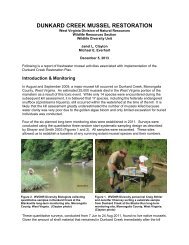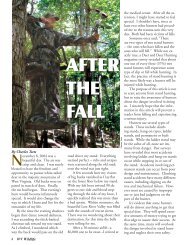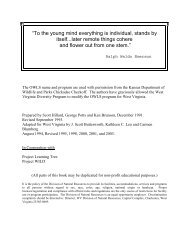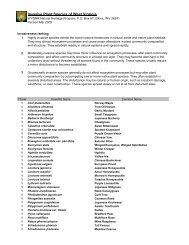Snakes - West Virginia Division of Natural Resources
Snakes - West Virginia Division of Natural Resources
Snakes - West Virginia Division of Natural Resources
Create successful ePaper yourself
Turn your PDF publications into a flip-book with our unique Google optimized e-Paper software.
<strong>Snakes</strong> Of <strong>West</strong><br />
<strong>Virginia</strong><br />
Because <strong>of</strong> irrational fears, snakes are perhaps the most misunderstood<br />
creatures in <strong>West</strong> <strong>Virginia</strong>. These fears that are passed from<br />
one generation to another make many state residents shudder at<br />
the very thought <strong>of</strong> snakes. Yet these members <strong>of</strong> the reptile class play<br />
a vital role in the balance <strong>of</strong> nature. Their colorful and complex life<br />
histories are fascinating and give little justifi cation for the apprehension<br />
felt by so many.<br />
The fear <strong>of</strong> being bitten causes many persons to senselessly kill any<br />
snake they see. Yet, <strong>of</strong> the 20 species <strong>of</strong> snakes found in the Mountain<br />
State, only two are venomous, the Northern Copperhead and Timber<br />
Rattlesnake. Although the majority <strong>of</strong> venomous snake bites in <strong>West</strong><br />
<strong>Virginia</strong> are from copperheads, no fatalities from copperheads have been<br />
recorded in over 30 years. From 1969 to 1992 only four people in the<br />
Mountain State have died from rattlesnake bites while in the wild. Bee<br />
stings, cows and horses caused 15 times as many deaths as snakes. Up<br />
to one-half <strong>of</strong> venomous snake bites result in no venom being injected.<br />
If, however, you are bitten by a venomous snake, see a doctor or go to a<br />
hospital immediately.<br />
While the danger from snake bites is exaggerated, the ecological<br />
value <strong>of</strong> snakes is <strong>of</strong>ten overlooked. <strong>Snakes</strong> provide an essential<br />
pest-control service as a result <strong>of</strong> their feeding habits. While all snakes<br />
contribute to this service, some species are particularly benefi cial. Both<br />
species <strong>of</strong> black snakes, kingsnakes, Timber Rattlesnakes and Eastern<br />
Milksnakes are well-known rodent predators. Enlightened <strong>West</strong> <strong>Virginia</strong><br />
farmers encourage black snakes to make their home in the barn where<br />
the harmless reptile controls rat and mouse populations. While smaller<br />
kingsnakes consume large quantities <strong>of</strong> insects, larger kingsnakes may<br />
also feed on snakes.<br />
Understanding the feeding<br />
habits <strong>of</strong> snakes is important if<br />
one wants to control them.<br />
<strong>Snakes</strong> can be discouraged<br />
from staying around yards<br />
and buildings by eliminating food<br />
and cover attractive to them. Because many<br />
snakes feed on rodents, it is advisable to make<br />
Mountain Earthsnake<br />
3<br />
Sam Norris












